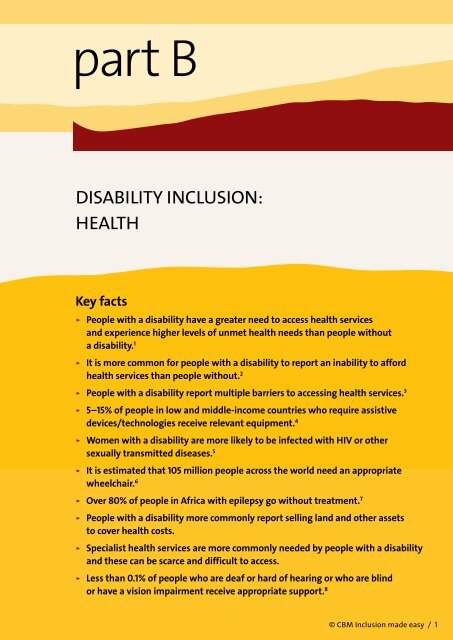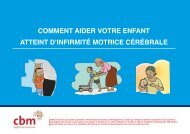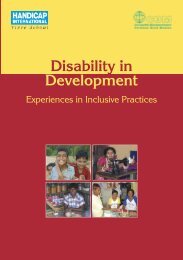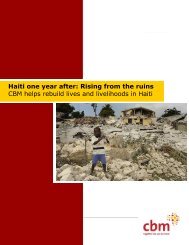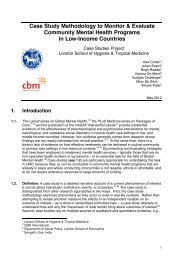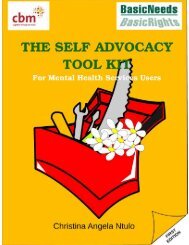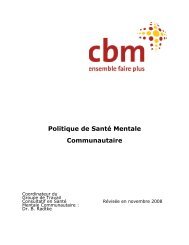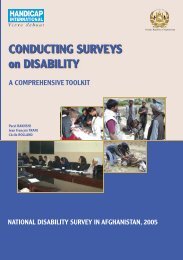Inclusion Made Easy: Health - CBM
Inclusion Made Easy: Health - CBM
Inclusion Made Easy: Health - CBM
- No tags were found...
You also want an ePaper? Increase the reach of your titles
YUMPU automatically turns print PDFs into web optimized ePapers that Google loves.
How to include people with a disability in health programsMainstreaming disability into health programs will ensure many of the barriersexperienced by people with a disability are removed and their right to health isachieved.The following principles, which adhere to a human-rights approach todisability are used to demonstrate inclusion of people with a disability inall development programs and sectors.Awareness of disability and its implications.Participation and active involvement of people with a disability.Comprehensive accessibility through addressing physical,communication, policy and attitudinal barriers.Twin track identifying disability specific actions combined withmainstream approaches.© <strong>CBM</strong> <strong>Inclusion</strong> made easy / 3
Awareness▹▹Identify the number of people with a disability within the community.This information can be gathered, for example, through meeting local peoplewith a disability and DPOs, census data, household surveys, Community-BasedRehabilitation (CBR) and disability services and facilities for inclusive education.▹▹Provide information regarding disability to health professionals to ensure thereis up-to-date knowledge on prevalence and impact of disability.▹▹Use people with a disability in awareness-raising activities.▹▹Highlight the role played by the health sector in preventing impairment.▹▹Encourage awareness-raising efforts by disability service providers and DisabledPeoples Organisations (DPOs) with their local health providers.▹▹Advocate for the inclusion of disability within broader health policies, strategies,programs and monitoring mechanisms.▹▹Ensure billboards, posters or other health promotion information depicts peoplewith a disability as part of the general population.Participation▹▹Build relationships with people with a disability and DPOs to gain their activeparticipation within the program.▹▹Ensure direct consultation with people with a disability for identification of theirhealth-related barriers.▹▹Allocate a budget to cover travel and participation expenses along withattendance time for people with a disability and DPOs to actively be involved inconsultations.▹▹Employ someone with a disability within the health service to ensure activeparticipation and representation within the program.▹▹Promote people with a disability as health care workers to demonstrate theirskills and capacity along with improving representation of service recipients.▹▹Develop strong linkages between health and disability stakeholders.4 / © <strong>CBM</strong> <strong>Inclusion</strong> made easy
Comprehensive accessibilityComprehensive accessibility = physical, communication, policyand attitudinal access▹▹Hold consultations in physically accessible venues.▹▹Identify the preferred communication mode for individuals with a disability.Note that not all people who are blind will have been taught Braille, likewise,not all individuals who are deaf or hard of hearing will have sign language skills.▹▹Be prepared to source alternative communication options including large print,Braille, pictorial, audio and sign language based on individual requirements.These may be arranged through local partners, inclusive education services,CBR and disability organisations.▹▹Improve physical access to health services including hospitals, communityhealth services and outreach clinics.▹▹Build capacity of health care workers in communicating with people witha disability.▹▹Build capacity of health services in order to meet the basic health requirementsof early identification and diagnosis of impairment, with appropriate referralsto specialist medical and disability services.▹▹Address financial barriers to health services for people with a disability,embedding disability related funding strategies within policies.▹▹Pay particular attention to women and girls with a disability as they are oftenseverely marginalised, experiencing numerous challenges, including sexualand physical violence.▹▹Sexual reproductive health programs should be particularly aware and inclusiveof the requirements of women with a disability. 10▹▹National health plans and strategies, or vertical health programs, may nothave considered the specific needs of vulnerable groups. Work towards greaterinclusion of a disability perspective in all future plans.▹▹Address attitudes to improve participation of people with a disability.▹ ▹ Use people with a disability and engage DPOs for capacity developmentactivities around attitude, access and rights.© <strong>CBM</strong> <strong>Inclusion</strong> made easy / 5
Twin trackTwin track enables full inclusion through mainstream accessworking alongside disability specific supportsMainstreamPromote disability inclusion inhealth programs.Ensure all data collected duringprograms can be disaggregated bydisability, age and gender.Adopt universal design principlesfor all health services. Ensure healthfacilities are built with accessiblefeatures, including ramps, wideneddoorways, accessible toilets,appropriate signage and adjustableheight beds that will be useful fora range of purposes.Advocate for the inclusion ofdisability within broader healthpolicy, programs and monitoringmechanisms.Support initiatives that builddisability inclusion into the healthtraining curricula. Engage peoplewith a disability in training efforts.Depict people with a disability asmembers of the general populationin health, education and healthpromotion messages.Disability specificSupport initiatives that strengthendisability and specialist medicalservices.Facilitate access to all disability andspecialist medical services includingthe cost of assistive devices ormedication.Work closely with local disabilityorganisations to promote healthservices through their networks.Promote the active engagement ofpeople with a disability and DPOsin advocacy efforts with their localhealth service providers.Map all specialist medical anddisability services, including referralprocesses, and disseminate widely invaried formats.Promote the early identification ofdisability in childhood and establishappropriate referrals to disabilityservices.Support development anddissemination of clinical guidelinesfor commonly occurring impairmenttypes (e.g. club foot).6 / © <strong>CBM</strong> <strong>Inclusion</strong> made easy
CASE STUDY:UTTARAKHAND CLUSTER OF THE COMMUNITY HEALTHGLOBAL NETWORK (CHGN)Nossal Institute of Global <strong>Health</strong>The Uttarakhand Community <strong>Health</strong> Cluster is a unique network of communityhealth programs based in the Northern India state of Uttarakhand. Launchedin 2008 as part of the Community <strong>Health</strong> Global Network, the cluster now has40 member organisations covering a catchment area of approximately threemillion people. The members come together for mutual knowledge sharing andprogram strengthening.During a biannual learning and sharing workshop, the Uttarakhand Clusteridentified the need for knowledge, skills and resources to address a growingconcern that people with a disability were excluded from the benefits of existinghealth programs. This began the planning of a disability-inclusive developmentproject across the cluster. Supported by the Nossal Institute for Global <strong>Health</strong>,a disability situational analysis was conducted to identify key stakeholders andareas of gaps and opportunities. Following an initial disability training workshop,representatives from each of the programs collectively agreed upon goals topromote inclusion of people with a disability into existing health programs,including the following:1. To ensure people with a disabilityhave equal access to and benefitfrom all health and developmentactivities in the 40 Clusterprograms.2. To strengthen the existingdisability specific interventionsand initiate some further disabilityspecific projects in the Cluster.© <strong>CBM</strong>-Nossal3. To empower people with a disabilityto work for the realisation of their rights through the establishmentand networking between self-help groups and DPOs.Outcomes included training programs for project staff and community healthvolunteers, with a focus on awareness-raising, addressing stigma, earlyidentification and referral to disability services in the region. The community alsoinitiated a collaboratively produced disability awareness DVD.Three health professionals from the cluster completed an Australian LeadershipAward Fellowship. One of these representatives has been appointed as the ClusterDisability Advisor to coordinate the implementation of disability-inclusive actionsacross the 40 cluster programs using the skills, tools and training programsdeveloped.© <strong>CBM</strong> <strong>Inclusion</strong> made easy / 7
CASE STUDY:UTTARAKHAND CLUSTER OF THE COMMUNITY HEALTHGLOBAL NETWORK (CHGN) (CONT’D)Future directionsActivities to be conducted in the next stage ofthe project include:▹▹Collecting baseline data to better understand the barriers experienced by peoplewith a disability when accessing health services.▹▹Training cluster program leaders and appointed disability coordinators fromeach of the programs to facilitate, lead and review the implementation ofdisability-inclusion activities across the 40 health programs.▹▹Facilitating organisational assessments and development of action plans foreach health program to identify and implement:– mainstreaming activities (e.g. addressing physical barriers or skills andattitudes of health workers to ensure that people with a disability have equalaccess to health services), and– disability specific programs (e.g. improving capacity for rehabilitation,or the provision of assistive devices such as wheelchairs).▹▹Establishing, supporting and building the capacity of DPOs.▹▹Developing new CBR programs in selected health services.Lessons learnedDespite a commitment by the 40 cluster programs to ensure people witha disability benefit equally from community health programs, the cluster hasidentified a long list of activities that at first appears to be overwhelming inthe context of other competing priorities. However, the Uttarakhand Clusterhas identified simple sustainable strategies for action, beginning first withawareness-raising activities, acknowledging that barriers extend beyond simplyphysical access to health centre buildings. These activities reflect a twin trackapproach including a variety of disability-specific measures, along with activitiesthat ensure people with a disability are included in existing programs.These strategies will be facilitated by the allocated focal points within thecluster, ensuring that people with a disability are actively involved throughoutthe planning, implementation and evaluation of programs.One of the project staff reflected on the lesson he learnt about the value ofparticipation for people with a disability when he said, “I have never workedwith or had a friend with a disability. I never really understood what barriers theyexperience. Now I have new friends and I am excited about the changes we canmake in our health programs to ensure everyone is included”.8 / <strong>CBM</strong> <strong>Inclusion</strong> made easy
Useful resources for disability inclusion in health programs■■Source International Information Support Centre:http://www.asksource.info/about/news_na.htm■■Australian Development Gateway, Disability Inclusive Development, <strong>Health</strong>:http://www.developmentgateway.com.au/cms/op/preview/sectors/did/page985.htmlhttp://www.who.int/topics/disabilities/en/■■Promoting Sexual and Reproductive <strong>Health</strong> for Persons with Disabilities. (2009).UNFPA/WHO Guidance Note: http://www.unfpa.org/webdav/site/global/shared/documents/publications/2009/srh_for_disabilities.pdf■■World Report on Disability.(2011). WHO:http://www.who.int/disabilities/world_report/2011/en/index.html■■Maxwell, J., Watts Belser, J. & David, D. (2007). A <strong>Health</strong> Handbook for Womenwith Disabilities. Hesperian Foundation: http://hesperian.org/wp-content/uploads/pdf/en_wwd_2008/en_WWD_2008_full%20book.pdf© <strong>CBM</strong>-A 1110 / © <strong>CBM</strong> <strong>Inclusion</strong> made easy
References1. WHO & World Bank. (2011). World Report on Disability. Retrieved fromhttp://www.who.int/disabilities/world_report/2011/en/index.html2. WHO & World Bank. (2011). World Report on Disability. Retrieved fromhttp://www.who.int/disabilities/world_report/2011/en/index.html3. VanLeit, B., Rithy, P. & Channa, S. (2007). Secondary Prevention of Disabilitiesin the Cambodian Provinces of Siem Reap and Takeo: Perceptions of and useof the health system to address health conditions associated with disability inchildren. Report prepared for Handicap International Brussels. Retrieved fromhttp://siteresources.worldbank.org/DISABILITY/Resources/News---Events/BBLs/070517HIrptCambodia.pdf4. WHO. (2006). Assistive Devices/Technologies. Retrieved fromhttp://www.who.int/disabilities/technology/en/5. Groce, N. (2003). ‘HIV/AIDS and people with disability.’ Lancet, 361,pp. 1401–1402.6. Motivation. (2012). Mobility: Helping to achieve freedom through mobility.Retrieved from http://www.motivation.org.uk/what-we-do/our-programmes/mobility/7. WHO. (2009). ‘Epilepsy’ Factsheet No. 999. Retrieved fromhttp://www.who.int/mediacentre/factsheets/fs999/en/8. WHO. (2001). World <strong>Health</strong> Report in the New Internationalist (2005)‘Disability in the Majority World’. New Internationalist: Global9. WHO. (2002). WHO Conference on <strong>Health</strong> and Disability.10. WHO & United Nations Population Fund. (2009). Promoting Sexual andReproductive <strong>Health</strong> Programs for Persons with Disabilities: UNFPA/WHOGuidance Note. Retrieved from http://www.unfpa.org/public/publications/pid/38511. Abdul Gafur’s story in his own words can be read at www.endthecycle.org.au/Abdul-Gafur© <strong>CBM</strong> <strong>Inclusion</strong> made easy / 11


